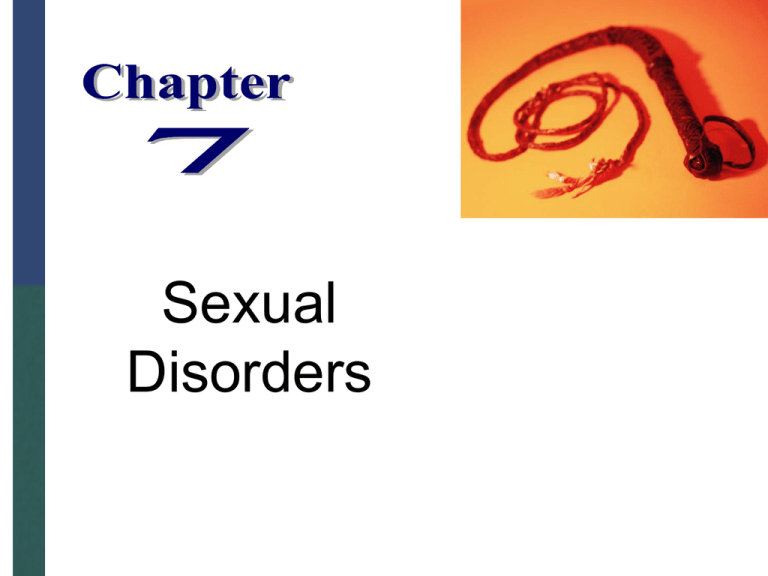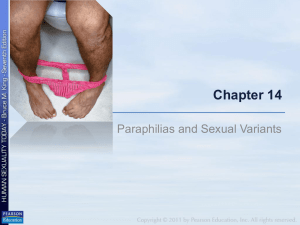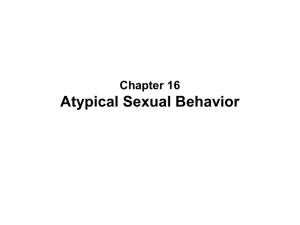
Sexual
Disorders
What is Abnormal
Sexual Behavior?
Sexual behavior is considered a
psychological disorder if it causes:
• harm to other people,
• persistent or recurrent distress, or
• impairment in important areas of
functioning.
Paraphilias
Paraphilias
para = abnormal; philia = attraction
• Disorders in which an individual has
recurrent, intense sexually arousing
fantasies, sexual urges, or behaviors
involving
– nonhuman objects,
– children or other nonconsenting persons, or
– the suffering or humiliation of self or partner.
• Inability to experience sexual gratification
in the absence of the desired stimulus.
• Lasting at least six months.
FEATURES OF PARAPHILIAS
•
•
•
•
Vary by paraphilia.
Biopsychosocial factors.
“Love Map” gone awry
Conditioning currently the most accepted
etiological explanation.
• Difficult to treat, and rarely present for
treatment unless legally bound.
• Treatment depends on the nature of the
paraphilia.
Pedophilia
Pedophilia:
A paraphilia in
which an adult's
sexual urges are
directed toward
children.
PEDOPHILIA
• Types of molester
– Situational molesters
– Preference molesters
– Child rapists
2/3 of all sexual assault victims are children & adolescents.
Vast majority of perpetrators are male.
Nearly 2/3 of the victims are female.
About 1/3 of offenders are relatives of the victimized children.
THEORIES
• EARLY LIFE EXPERIENCE
Sexually and emotionally abused as
children.
Victim-to-abuser cycle.
• PERSONALITY TRAITS
Antisocial personality traits.
Anger stemming from feelings of
inadequacy, introversion, cognitive rigidity.
TREATMENT
BIOLOGICAL APPROACH
IN DIAGNOSIS
Penile plethysmograph.
IN TREATMENT
Lowering testosterone.
Castration (rare).
Hypothalamotomy.
These may help curb sex drive, but inappropriateness
of the choice of partner must also be addressed.
TREATMENT
• BEHAVIORAL TREATMENT
Aversive therapy.
Ridicule.
• COGNITIVE
Cognitive restructuring
Relapse prevention
• GROUP THERAPY
Confront denial and rationalizations.
Supportive context to discuss desires and
conflicts.
Exhibitionism
Exhibitionism:
A paraphilia in which a person has intense sexual
urges and arousing fantasies involving the
exposure of genitals to a stranger.
.
Frotteurism:
from French frotter (“to rub”)
A paraphilia in which the individual has
intense sexual urges and sexually
arousing fantasies of rubbing against or
fondling an unsuspecting stranger.
Voyeurism:
from French voir (“to see”)
A paraphilia in which the individual has a
compulsion to derive sexual gratification from
observing the nudity or sexual activity of
others.
Covert Conditioning:
Sexual Masochism
Attraction to achieving sexual
gratification by having painful
stimulation applied to one's
own body, either alone or with
a partner.
Distress or impairment
Sexual Sadism
Deriving sexual gratification
from activities (real, not
simulated) that harm, or
from urges to harm or
humiliate another
(unconsenting) person.
The term sadomasochist refers to
someone who derives pleasure from
both inflicting and receiving pain.
Fetishism:
A paraphilia in which the individual is
preoccupied with an object and
depends on this object rather than
sexual intimacy with a partner for
achieving sexual gratification.
Behavior is not fetishistic when
involving an object specifically
designed for sexual excitation
(e.g., vibrator).
Orgasmic Reconditioning:
Continuum for Normal-Abnormal
Behavior
Transvestic fetishism:
Transvestic Fetishism
A paraphilia in which a
man has an
uncontrollable
craving to dress in
women's clothing in
order to derive sexual
gratification.
Homosexual men who
makes themselves up as
women are not transvestic
fetishists because they are
not dressing this way to
gain sexual satisfaction.
Classical Conditioning in
Paraphilias
• Fetish to Silk Stocking
– UCS – genital arousal
– UCR – sexual pleasure
– CS – sight or feel of stockings
– CR – sexual pleasure
Gender Identity
Disorder
Gender identity:
The individual's self-perception as a
male or female.
Gender identity disorder:
A condition in which there is a
discrepancy between an individual's
gender identity and assigned
(biological) sex.
GENDER IDENTITY DISORDER
• Strong and persistent (but not delusional)
belief that they are the wrong sex.
• Refusal to engage in culturally “genderappropriate” behaviors.
• Recurrent fantasies of being the opposite
gender and cross-dressing.
• Without sexual gratification from crossdressing.
Specific Diagnostic Criteria
• Child behaviors signifying cross gender identity (at least
four)
–
–
–
–
–
Stated desire to be other sex
Cross-dressing
Cross-sex role play
Cross-sex toy and activity preference
Cross-sex peer affiliation
• In adults/adolescents, expressed as desires/behaviors to
be the other sex
• Above are evidenced repeatedly, strongly and persistently, intensely
• Discomfort with sex or feels inappropriateness of gender.
THEORIES OF GENDER
IDENTITY DISORDER
• BIOLOGICAL
Abnormal fetal hormone levels.
Vulnerability to high sensory arousal.
Birth Order
Sensitive to parents’ emotional expressions.
• PSYCHOLOGICAL
Parental preferences for child of other sex.
Parental unintentional reinforcement of crossgender behaviors.
• SOCIAL - Cultural idealization of stereotypical male
and female “types.”
TREATMENT
• PSYCHOTHERAPY
– Very young child
• Help develop self-esteem VS.
• Require child to live as biological sex
– Older child/Early Adolescent
• Deal with cross-gender behavior and fantasy, low selfesteem, peer rejection VS
• Require child to live as biological sex
– Adults
• Focus on the biopsychosocial causes, provide support and
coping strategies, surgery
SEX REASSIGNMENT
SURGERY
• Sought by a small number of those with
gender identity disorder.
• Factors in improved functioning postsurgery:
– Female-to-male transition hold greater
satisfaction.
– Level of adjustment pre-surgery.
– Level of commitment to being other sex.
– Quality of surgery itself.
The Biopsychosocial Perspective
• Behavioral perspective appears to hold the most
promise in explaining sexual disorders overall.
• Behavioral treatments of sexual disorders can
be applied to the paraphilias and sexual
dysfunctions.
• Biological perspective is important, too,
especially with gender identity disorders.
• Exploring personal history and relationship
difficulties is important.










